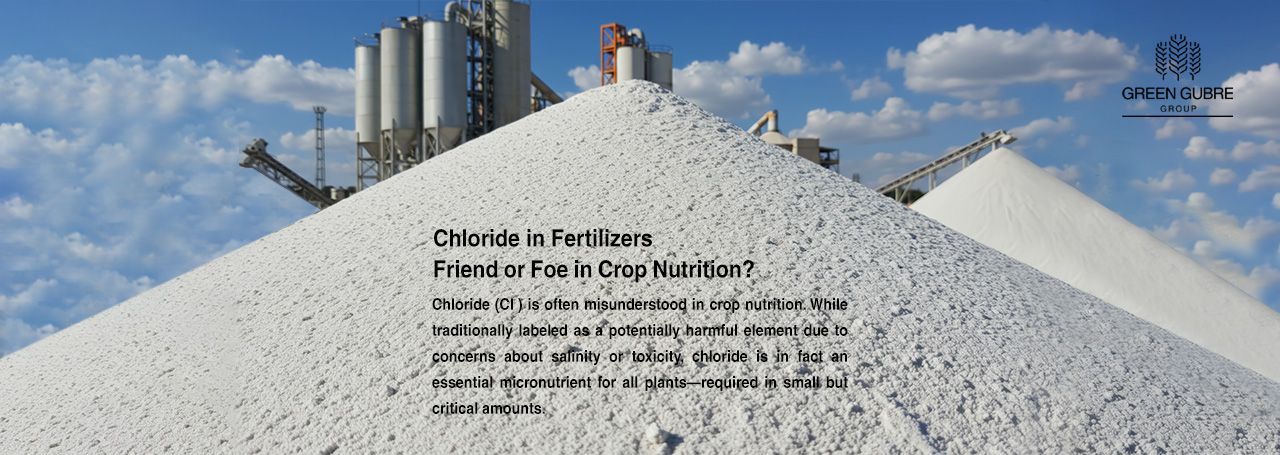Chloride in Fertilizers – Friend or Foe in Crop Nutrition?
Chloride in Fertilizers – Friend or Foe in Crop Nutrition?

Introduction: Understanding Chloride’s Dual Role
Chloride (Cl⁻) is often misunderstood in crop nutrition. While traditionally labeled as a potentially harmful element due to concerns about salinity or toxicity, chloride is in fact an essential micronutrient for all plants—required in small but critical amounts. However, its behavior in the soil and interaction with other nutrients can determine whether it supports or harms crop performance.
Farmers must learn how to manage chloride wisely—especially in chloride-sensitive crops or soils prone to salinity—to balance its benefits and avoid unwanted consequences.
What is Chloride and Why is it in Fertilizers?
Chloride is the anionic form of chlorine and occurs naturally in most soils. It plays key physiological roles in plants:
- Regulates osmotic pressure for water movement and cell turgor
- Assists in photosynthesis, especially oxygen evolution in chloroplasts
- Supports stomatal regulation and disease resistance
Chloride is commonly introduced via:
- Potassium chloride (KCl / Muriate of Potash) – Most widely used chloride-based fertilizer
- Ammonium chloride
- Calcium chloride (in foliar applications)
Benefits of Chloride in Crop Nutrition
Despite its reputation, chloride offers measurable benefits:
| Benefit | Impact on Crops |
|---|---|
| Enhances disease resistance | Helps resist fungal pathogens by strengthening leaf cuticles |
| Improves water use efficiency | Supports osmotic balance and reduces drought stress |
| Promotes potassium uptake | Maintains ionic balance in roots and xylem transport |
| Boosts certain crop yields | Particularly in cereals and oilseeds with Cl⁻ responsiveness |
Crops like wheat, barley, and canola often respond positively to small doses of chloride.
Source – Journal of Plant Nutrition
Risks of Excessive Chloride
While chloride is essential, excessive application or accumulation in the soil can cause problems, especially for chloride-sensitive crops. Risks include:
- Leaf scorch or tip burn in sensitive crops
- Salt accumulation in arid or poorly drained soils
- Nutrient antagonism, particularly with nitrate and phosphate
- Reduced fruit quality in certain horticultural crops (e.g., grape, tomato)
Sensitive crops include:
- Tobacco, grapes, citrus, strawberries, beans, and potatoes
Source – Fertilizer Focus Magazine
When to Use Chloride-Based Fertilizers
Chloride can be beneficial in:
- Well-drained soils with regular rainfall
- Cereal crops like wheat, sorghum, and corn
- Potassium-deficient fields where KCl is the most economical source
- Moderate climates, where leaching prevents salt accumulation
Avoid or limit chloride use in:
- High-salinity zones or arid climates
- Chloride-sensitive crop rotations
- Protected environments like greenhouses or tunnels
Best Practices for Chloride Management
- Soil Testing: Monitor baseline chloride levels, especially in irrigated fields
- Know Crop Sensitivity: Adjust application based on species and variety
- Use Alternative K Sources: For sensitive crops, use potassium sulfate (SOP) or potassium nitrate
- Split Applications: Apply chloride-based fertilizers in smaller, timed doses
- Irrigation Management: Flush chloride build-up with fresh water if needed
Chloride Fertilizers Offered by Green Gubre Group
We supply several chloride-based fertilizers suitable for different crops and environments:
- Muriate of Potash (MOP / KCl): Cost-effective potassium source for grains and oilseeds
- Ammonium Chloride: High-nitrogen product used in alkaline soils
- Calcium Chloride (Liquid / Powder): Used for foliar applications to correct Cl⁻ deficiencies or as an anti-bitter pit treatment in fruits
Our agronomic advisors assist clients in selecting the optimal product for their unique soil and crop conditions.
Conclusion: Use Chloride Wisely for Maximum Benefit
Chloride is not a fertilizer villain—it’s a vital micronutrient that, when used responsibly, can improve yields, disease resistance, and water regulation. But like any input, balance is key. Through soil testing, informed crop selection, and strategic application, farmers can unlock the benefits of chloride without risking salt damage or nutrient imbalance.
Manage chloride like a pro—and make it a supporting player in your high-performance fertility program.




